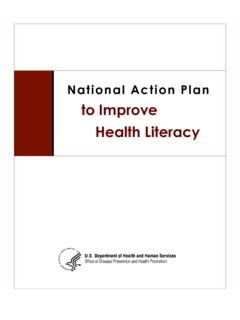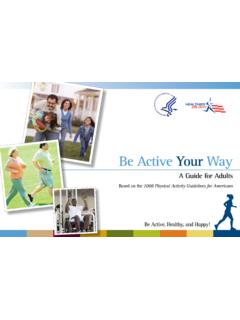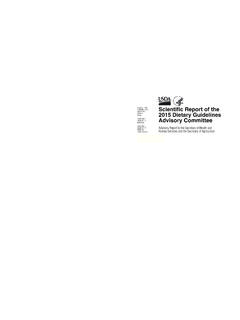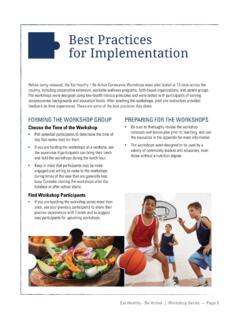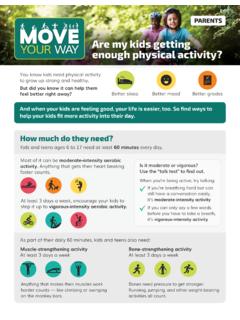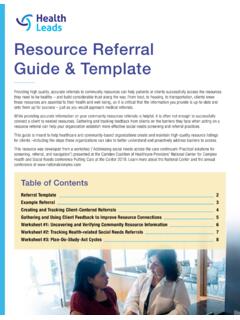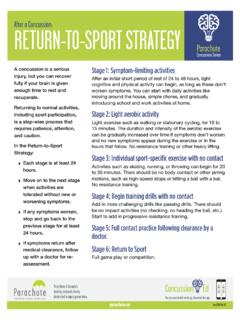Transcription of Benefits of Youth Sports - Health
1 Developed by the President s Council on Sports , Fitness & Nutrition Science BoardBenefits of Youth Sports1 Benefits of Youth Sports Developed by the PCSFN Science Board September 17, 2020 The national Youth Sports strategy aims to unite Youth Sports culture around a shared vision: that one day, all Youth will have the opportunity, motivation, and access to play Sports regardless of their race, ethnicity, sex, ability, or ZIP code. Why Youth Sports ? Research shows that participating in Youth Sports can lead to immediate and long-term Benefits for Youth , their families, and communities. Mental, Emotional, and Social Health 73 percent of parents believe that Sports benefit their child s mental And they are right! Participating in Sports is associated with: Lower rates of anxiety and depression2 5 Lower amounts of stress5,6 Higher self-esteem and confidence3,7 9 Reduced risk of suicide5,10,11 Less substance abuse and fewer risky behaviors5,8,12 Increased cognitive performance5,13 15 Increased creativity16 Greater enjoyment of all forms of physical activity17 Improved psychological and emotional well-being for individuals with disabilities18 Increased life satisfaction19,20 Physical Health 88 percent of parents believe that Sports benefit their child s physical Indeed, participation is one way for Youth to get the physical activity they need to be fit and healthy.
2 Participating in physical activity is associated with: Improved bone health21 Improved weight status5,21 Increased cardiorespiratory and muscular fitness5,21 Reduced risk of cancer and diabetes22,23 Participating in Sports is associated with: Increased physical activity levels24 Improved cardiovascular fitness24 Decreased body fat percentage for girls24 Increased overall quality of life19,20 Developed by the President s Council on Sports , Fitness & Nutrition Science BoardBenefits of Youth Sports2 Educational and Career Success 55 percent of parents believe that Sports will benefit their children academically and improve their future careers. 80 percent of parents believe that Sports helped their child learn about discipline and dedication, as well as how to get along with Research supports these beliefs.
3 Participating in Sports is associated with: Improved teamwork, social skills, and social responsibility3,9 Improved life skills ( , goal setting, time management, work ethic, empathy, negotiation)9,25,26 Increased empowerment, personal responsibility, and self-control9,27 Improved educational and occupational skills ( , determination, perseverance, grit, resilience, critical thinking)9 Higher levels of academic achievement5,28 34 Greater leadership qualities5,35 37 High school athletes are more likely to attend and graduate from a four-year college10,33,38 41 Lifelong Participation 73 percent of adults who play Sports participated when they were This means they built the habit of physical activity early and are reaping the rewards in adulthood.
4 Lifelong participation in Sports can lead to improved mental Health ,42 Over 50% of adults who participate in Sports believe that participation reduces stress and improves mental Adolescents who play Sports are 8 times more likely to be physically active at age 24 than those who do not play Participating in Sports leads to immediate psychological Benefits , and these can continue even after retirement from Economic and Community Impact The Benefits of Youth Sports extend beyond the field and even beyond the participant. Participating in Sports and physical activity can lead to: A decrease in direct, indirect, and personal Health care costs (collectively, up to $28 billion per year)45 47 A stronger long-term labor market48,49 Developed by the President s Council on Sports , Fitness & Nutrition Science BoardBenefits of Youth Sports3 References 1.
5 national Public Radio, Robert Wood Johnson Foundation, Harvard Chan School of Public Health . Sports and Health in America; 2015. research/2015/06 2. Sanders CE, Field T, Diego M, Kaplan M. Moderate involvement in Sports is related to lower depression levels among adolescents . Adolescence. 2000;35(140):793-797. Accessed July 10, 2020. 3. Eime RM, Young JA, Harvey JT, Charity MJ, Payne WR. A systematic review of the psychological and social Benefits of participation in sport for children and adolescents: informing development of a conceptual model of Health through sport. Int J Behav Nutr Phys Act. 2013;10(1):98. 4. Pluhar E, McCracken C, Griffith KL, Christino MA, Sugimoto D, Meehan WP. Team sport athletes may be less likely to suffer anxiety or depression than individual sport athletes.
6 J Sports Sci Med. 2019;18(3):490-496. Accessed July 10, 2020. 5. Logan K, Cuff S, LaBella CR, et al. Organized Sports for children, preadolescents, and adolescents. Pediatrics. 2019;143(6). 6. Jewett R, Sabiston CM, Brunet J, O Loughlin EK, Scarapicchia T, O Loughlin J. School sport participation during adolescence and mental Health in early adulthood. J Adolesc Health . 2014;55(5):640-644. 7. Harrison PA, Narayan G. Differences in behavior, psychological factors, and environmental factors associated with participation in school Sports and other activities in adolescence. J Sch Health . 2003;73(3):113-120. 8. Key Findings | Healthy Sport Index | Healthy Sport Index | Aspen Institute Sports and Society Program. Healthy Sport Index. Accessed July 10, 2020. 9.
7 Whitley MA, Massey WV, Wilkison M. A systems theory of development through sport for traumatized and disadvantaged Youth . Psychol Sport Exerc. 2018;38:116-125. 10. Women s Sports Foundation. Health Risks and the Teen Athlete. 2000. Accessed July 10, 2020. https://www. 11. Staurowsky EJ, DeSousa MJ, Ducher G, et al. Her Life Depends On It II: Sport, Physical Activity, and the Health and Well-Being of American Girls and Women . 2009. Accessed July 10, 2020. 12. Kwan M, Bobko S, Faulkner G, Donnelly P, Cairney J. Sport participation and alcohol and illicit drug use in adolescents and young adults: a systematic review of longitudinal studies. Addict Behav. 2014;39(3):497-506. 13. Pich G, Fitzpatrick C, Pagani LS. Associations between extracurricular activity and self-regulation: a longitudinal study from 5 to 10 years of age.
8 Am J Health Promot. 2015;30(1):e32-e40. 14. Hillman CH, Pontifex MB, Castelli DM, et al. Effects of the FITKids randomized controlled trial on executive control and brain function. Pediatrics. 2014;134(4):e1063-e1071. 15. Hillman CH, Castelli DM, Buck SM. Aerobic fitness and neurocognitive function in healthy preadolescent children. Med Sci Sports Exerc. 2005;37(11):1967-1974. 16. Bowers MT, Green BC, Hemme F, Chalip L. Assessing the relationship between Youth sport participation settings and creativity in adulthood. Creat Res J. 2014;26(3):314-327. 17. Michael SL, Coffield E, Lee SM, Fulton JE. Variety, enjoyment, and physical activity participation among high school students. J Phys Act Health . 2016;13(2):223-230. 18. Puce L, Marinelli L, Girtler NG, et al.
9 Self-perceived psychophysical well-being of young competitive swimmers with physical or intellectual impairment. Percept Mot Skills. 2019;126(5):862-885. 19. Yazicioglu K, Yavuz F, Goktepe AS, Tan AK. Influence of adapted Sports on quality of life and life satisfaction in sport participants and non-sport participants with physical disabilities. Disabil Health J. 2012;5(4):249-253. 20. Groff DG, Lundberg NR, Zabriskie RB. Influence of adapted sport on quality of life: perceptions of athletes with cerebral palsy. Disabil Rehabil. 2009;31(4):318-326. 21. 2018 Physical Activity Guidelines Advisory Committee. 2018 Physical Activity Guidelines Advisory Committee Scientific Report. Part F. Chapter 8: Youth . Washington, DC: Department of Health and Human Services; 2018.
10 22. Moore SC, Lee IM, Weiderpass E, et al. Association of leisure-time physical activity with risk of 26 types of cancer in million adults. JAMA Intern Med. 2016;176(6):816-825. 23. Arslanian S, Bacha F, Grey M, Marcus MD, White NH, Zeitler P. Evaluation and management of Youth -onset type 2 diabetes: A position statement by the American diabetes association. Diabetes Care. 2018;41(12):2648-2668. 24. Telford RM, Telford RD, Cochrane T, Cunningham RB, Olive LS, Davey R. The influence of sport club participation on physical activity, fitness and body fat during childhood and adolescence: the LOOK Longitudinal Study. J Sci Med Sport. 2016;19(5):400-406. 25. Hermens N, Super S, Verkooijen KT, Koelen MA. A systematic review of life skill development through Sports programs serving socially vulnerable Youth .
